Samsung ML-1910, ML-1915, ML-2525, ML-2525W, ML-2580N Service Manual
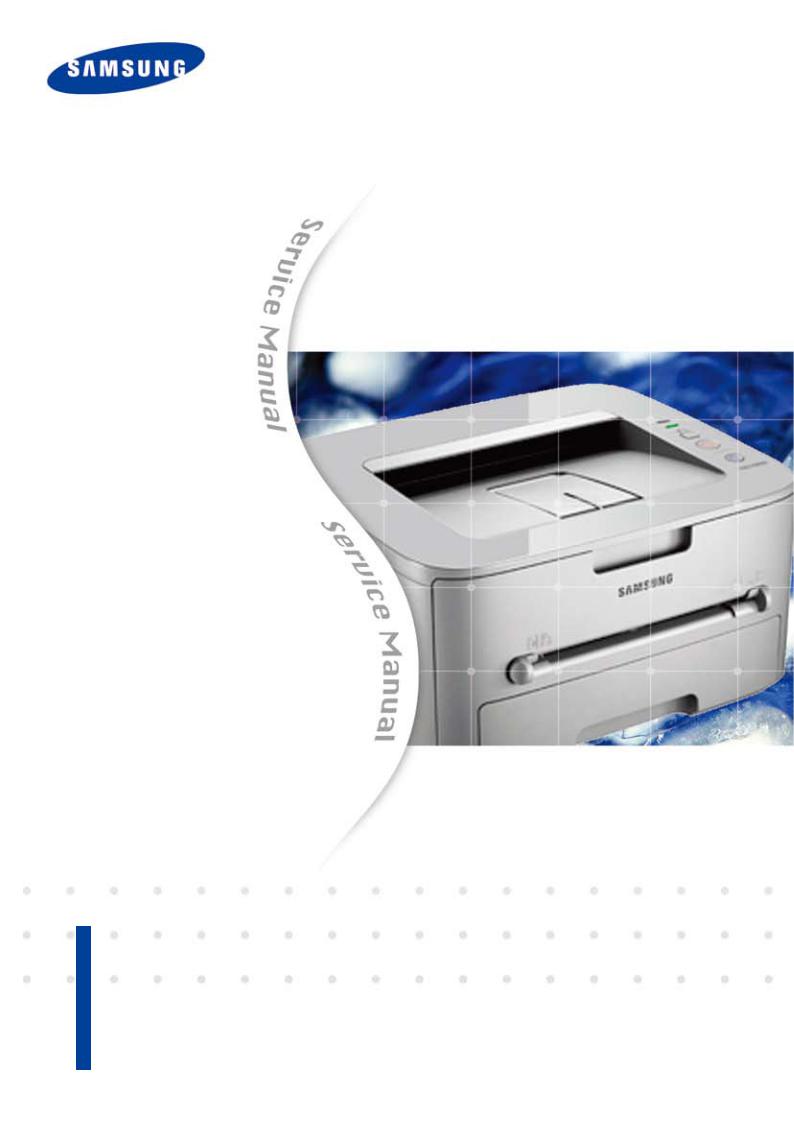
Service Manual
The keynote of Product
1.Speed
•ML2525/2525W/2580N : 24 ppm in A4
•ML1910/1915 : 18 ppm in A4
2.Processor
•Jupiter4e 150 Mhz
•Chorus3 360 Mhz (Only 2525W, 2580N)
3.Printer Language Emulations
•SPL, PCL6 (Only 2580N)
Laser Printer
ML-1910/1915 ML-2525/2525W/2580N
4.Memory
•8 MB / 64 MB (Only 2525W, 2580N)
5.Interfaces
•One USB port
•One 10/100 BaseT network connector (2580N)
•One IEEE 802.11 b/g wireless LAN (2525W)
6.Toner cartridge
•Initial : 0.7K (1910/ 1915) / 1K (2525/2525W/2580N)
•Sales : 1.5K / 2.5K two types

GSPN (Global Service Partner Network)
North America : service.samsungportal.com Latin America : latin.samsungportal.com CIS : cis.samsungportal.com
Europe : europe.samsungportal.com China : china.samsungportal.com Asia : asia.samsungportal.com
Mideast & Africa : mea.samsungportal.com
Samsung Electronics Co.,Ltd. February. 2008 Printed in Korea.
VERSION NO. : 1.00 CODE : 2580-00000E

Contents
chapter 1 Precautions
1.1Safety Warning……………………………………………………… 1-1
1.2Caution for safety…………………………………………………… 1-2
1.2.1Toxic material…………………………………………………… 1-2
1.2.2 Electric Shock and Fire Safety Precautions… ……………… 1-2 |
|
1.2.3 Handling Precautions… ……………………………………… |
1-3 |
1.2.4 Assembly / Disassembly Precautions………………………… |
1-3 |
1.2.5 Disregarding this warning may cause bodily injury… ……… |
1-4 |
1.3 ESD Precautions… ………………………………………………… |
1-5 |
chapter 2 Product Overview
2.1Product Specifications……………………………………………… 2-1
2.1.1Product Overview……………………………………………… 2-1
2.1.2Specifications………………………………………………… 2-2
2.1.3Model Comparison Table……………………………………… 2-9
2.2System Overview…………………………………………………… 2-10
2.2.1Front View……………………………………………………… 2-10
2.2.2Rear View… …………………………………………………… 2-11
2.2.3System Layout… ……………………………………………… 2-12
2.2.4Engine H/W Specifications… ………………………………… 2-19
2.2.5 |
Engine F/W Contol Algorithm………………………………… |
2-27 |
2.2.6 |
S/W Descriptions… …………………………………………… |
2-29 |
chapter 3 Maintenance and Disassembly
3.1 Precautions when replacing parts………………………………… 3-1
3.1.1 Precautions when assembling and disassembling………… |
3-1 |
|
3.1.2 |
Preautions when handling PBA… …………………………… 3-1 |
|
3.1.3 |
Releasing Plastic Latches… ………………………………… |
3-1 |

Contents
3.2 Screws used in the printer… ……………………………………… 3-2
3.3Cover………………………………………………………………… 3-3
3.3.1Front Cover… ………………………………………………… 3-3
3.3.2Top Cover… …………………………………………………… 3-3
3.3.3Rear Cover…………………………………………………… 3-4
3.3.4Right Cover… ………………………………………………… 3-5
3.3.5Left Cover ……………………………………………………… 3-6
3.4Fuser Unit… ………………………………………………………… 3-7
3.4.1Whole Fuser Unit… …………………………………………… 3-7
3.4.2 |
Main Service parts of Fuser Unit… ………………………… |
3-8 |
3.4.3 |
Replacing the Main Service part of Fuser Unit…………… |
3-10 |
3.5LSU Unit…………………………………………………………… 3-18
3.6OPE PBA… ………………………………………………………… 3-19
3.7Drive Unit… ………………………………………………………… 3-19
3.8FAN…………………………………………………………………… 3-20
3.9Transfer Roller… …………………………………………………… 3-21
3.10 Main PBA and SMPS/HVPS board……………………………… 3-22
3.11Pick up roller… …………………………………………………… 3-25
3.12Cassette holder pad… …………………………………………… 3-26
chapter 4 Alignment and Troubleshooting
4.1 Alignment and Adjustments……………………………………… 4-1
4.1.1Control Panel…………………………………………………… 4-1
4.1.2Understanding the LEDs……………………………………… 4-2
4.1.3JAM Removal… ……………………………………………… 4-3
4.1.4Printing a report……………………………………………… 4-6
4.1.5Periodic Defective Image…………………………………… 4-10
4.1.6How to use DCU… …………………………………………… 4-11
4.1.7EDC Mode……………………………………………………… 4-16
4.1.8Firmware upgrade…………………………………………… 4-19
4.1.9 Using the smart panel program… …………………………… |
4-20 |
4.2 Troubleshooting…………………………………………………… |
4-22 |
|
|

Contents
4.2.1 Procedure of Checking the Symptoms……………………… 4-22
4.2.2Bad discharge… ……………………………………………… 4-25
4.2.3Malfunction…………………………………………………… 4-30
4.2.4Bad image……………………………………………………… 4-36
4.2.5 |
Network problems and solutions (Only ML-2580N)……… |
4-52 |
4.2.6 |
Fuser Problems and solutions… …………………………… |
4-54 |
chapter 5 System Diagram
5.1Block Diagram… …………………………………………………… 5-1
5.2Connection Diagram……………………………………………… 5-4
chapter 6 Reference Information
6.1 |
Tool for Troubleshooting… ………………………………………… |
6-1 |
6.2 |
Acronyms and Abbreviations… …………………………………… |
6-2 |
6.2.1Acronyms… …………………………………………………… 6-2
6.2.2Service Parts…………………………………………………… 6-4
6.3 |
A4 ISO 19798 Standard Pattern………………………………… 6-8 |
|
6.3.1 A4 ISO 19752 Standard Pattern……………………………… |
6-8 |
|
6.4 |
Selecting a location… ……………………………………………… |
6-9 |
attached Exploded Views & Parts List
* Please see the attached.
Power Cord… ………………………………………………………… 2 Thumbnail …………………………………………………………… 3
1.Main… ……………………………………………………………… 4
2.Top Cover………………………………………………………… 6
3.Cover… …………………………………………………………… 8

Contents
4.Front Cover………………………………………………………… 10
5.Rear Cover… ……………………………………………………… 12
6.Main Frame………………………………………………………… 14
7.Main Drive Bracket (ML-1910)…………………………………… 18
8.Main Drive Bracket (ML-2580N)… ……………………………… 20
9.Base Frame-Pick Up ……………………………………………… 22
10.Fuser… …………………………………………………………… 24
11.Cassette…………………………………………………………… 26

Precautions
1. Precautions
In order to prevent accidents and to prevent damage to the equipment please read the precautions listed below carefully before servicing the printer and follow them closely.
1.1 Safety Warning
(1)Only to be serviced by appropriately qualified service engineers.
High voltages and lasers inside this product are dangerous. This printer should only be serviced by a suitably trained and qualified service engineer.
(2)Use only Samsung replacement parts
There are no user serviceable parts inside the printer. Do not make any unauthorized changes or additions to the printer, these could cause the printer to malfunction and create electric shock or fire hazards.
(3)Laser Safety Statement
The Printer is certified in the U.S. to conform to the requirements of DHHS 21 CFR, chapter 1 Subchapter J for Class 1(1) laser products, and elsewhere, it is certified as a Class I laser product con-forming to the requirements of IEC 825. Class I laser products are not considered to be hazardous. The laser system and printer are designed so there is never any human access to laser radiation above a Class I level during normal operation, user maintenance, or prescribed service condition.
Warning >> Never operate or service the printer with the protective cover removed from Laser/
Scanner assembly. The reflected beam, although invisible, can damage your eyes. When using this product, these basic safety pre-cautions should always be followed to reduce risk of fire, electric shock, and injury to persons.
Service Manual |
1-1 |
Samsung Electronics |
|

Precautions
1.2 Caution for safety
1.2.1 Toxic material
This product contains toxic materials that could cause illness if ingested.
(1)If the LCD control panel is damaged it is possible for the liquid inside to leak. This liquid is toxic. Contact with the skin should be avoided, wash any splashes from eyes or skin immediately and contact your doctor. If the liquid gets into the mouth or is swallowed see a doctor immediately.
(2)Please keep Drum cartridge and Toner Cartridge away from children. The toner powder contained in the Drum cartridge and Toner Cartridge may be harmful and if swallowed you should contact a doctor.
1.2.2 Electric Shock and Fire Safety Precautions
Failure to follow the following instructions could cause electric shock or potentially cause a fire.
(1)Use only the correct voltage, failure to do so could damage the printer and potentially cause a fire or electric shock.
(2)Use only the power cable supplied with the printer. Use of an incorrectly specified cable could cause the cable to overheat and potentially cause a fire.
(3)Do not overload the power socket, this could lead to overheating of the cables inside the wall and could lead to a fire.
(4)Do not allow water or other liquids to spill into the printer, this can cause electric shock. Do not allow paper clips, pins or other foreign objects to fall into the printer these could cause a short circuit leading to an electric shock or fire hazard.
(5)Never touch the plugs on either end of the power cable with wet hands, this can cause electric shock.
When servicing the printer remove the power plug from the wall socket.
(6)Use caution when inserting or removing the power connector. The power connector must be inserted completely otherwise a poor contact could cause overheating possibly leading to a fire. When removing the power connector grip it firmly and pull.
(7)Take care of the power cable. Do not allow it to become twisted, bent sharply round corners or other wise damaged. Do not place objects on top of the power cable. If the power cable is damaged it could overheat and cause a fire or exposed cables could cause an electric shock. Replace a damaged power cable immediately, do not reuse or repair the damaged cable. Some chemicals can attack the coating on the power cable, weakening the cover or exposing cables causing fire and shock risks.
(8)Ensure that the power sockets and plugs are not cracked or broken in any way. Any such defects should be repaired immediately. Take care not to cut or damage the power cable or plugs when moving the machine.
(9)Use caution during thunder or lightening storms. Samsung recommend that this machine be disconnected from the power source when such weather conditions are expected. Do not touch the machine or the power cord if it is still connected to the wall socket in these weather conditions.
(10)Avoid damp or dusty areas, install the printer in a clean well ventilated location. Do not position the machine near a humidifier. Damp and dust build up inside the machine can lead to overheating and cause a fire.
(11)Do not position the printer in direct sunlight. This will cause the temperature inside the printer to rise possibly leading to the printer failing to work properly and in extreme conditions could lead to a fire.
(12)Do not insert any metal objects into the machine through the ventilator fan or other part of the casing, it could make contact with a high voltage conductor inside the machine and cause an electric shock.
Service Manual |
1-2 |
Samsung Electronics |
|

Precautions
1.2.3 Handling Precautions
The following instructions are for your own personal safety, to avoid injury and so as not to damage the printer
(1)Ensure the printer is installed on a level surface, capable of supporting its weight. Failure to do so could cause the printer to tip or fall.
(2)The printer contains many rollers, gears and fans. Take great care to ensure that you do not catch your fingers, hair or clothing in any of these rotating devices.
(3)Do not place any small metal objects, containers of water, chemicals or other liquids close to the printer which if spilled could get into the machine and cause damage or a shock or fire hazard.
(4)Do not install the machine in areas with high dust or moisture levels, beside on open window or close to a humidifier or heater. Damage could be caused to the printer in such areas.
(5)Do not place candles, burning cigarettes, etc on the printer, These could cause a fire.
1.2.4 Assembly / Disassembly Precautions
Replace parts carefully, always use Samsung parts. Take care to note the exact location of parts and also cable routing before dismantling any part of the machine. Ensure all parts and cables are replaced correctly. Please carry out the following procedures before dismantling the printer or replacing any parts.
(1)Check the contents of the machine memory and make a note of any user settings. These will be erased if the mainboard or network card is replaced.
(2)Ensure that power is disconnected before servicing or replacing any electrical parts.
(3)Disconnect printer interface cables and power cables.
(4)Only use approved spare parts. Ensure that part number, product name, any voltage, current or temperature rating are correct.
(5)When removing or re-fitting any parts do not use excessive force, especially when fitting screws into plastic.
(6)Take care not to drop any small parts into the machine.
(7)Handling of the OPC Drum
-The OPC Drum can be irreparably damaged if it exposed to light.
Take care not to expose the OPC Drum either to direct sunlight or to fluorescent or incandescent room lighting. Exposure for as little as 5 mins can damage the surface? photoconductive properties and will result in print quality degradation. Take extra care when servicing the printer. Remove the OPC Drum and store it in a black bag or other lightproof container. Take care when working with the covers(especially the top cover) open as light is admitted to the OPC area and can damage the OPC
Drum.
-Take care not to scratch the green surface of OPC Drum Unit.
If the green surface of the Drum Cartridge is scratched or touched the print quality will be compromised.
Service Manual |
1-3 |
Samsung Electronics |
|

Precautions
1.2.5 Disregarding this warning may cause bodily injury
(1)Be careful with the high temperature part.
The fuser unit works at a high temperature. Use caution when working on the printer. Wait for the fuser to cool down before disassembly.
(2)Do not put finger or hair into the rotating parts.
When operating a printer, do not put hand or hair into the rotating parts (Paper feeding entrance, motor, fan, etc.). If do, you can get harm.
(3)When you move the printer.
This printer weighs 6.55kg (ML-1910/1915) / 6.6kg (ML-2525/2525W/2580N) including toner cartridge and cassette. Use safe lifting and handling techniques. Use the lifting handles located on each side of the machine. Back injury could be caused if you do not lift carefully.
(4)Ensure the printer is installed safely.
The printer weighs 6.55kg (ML-1910/1915) / 6.6kg (ML-2525/2525W/2580N), ensure the printer is installed on a level surface, capable of supporting its weight. Failure to do so could cause the printer to tip or fall possibly causing personal injury or damaging the printer.
(5)Do not install the printer on a sloping or unstable surface. After installation, double check that the printer is stable.
Service Manual |
1-4 |
Samsung Electronics |
|

Precautions
1.3 ESD Precautions
Certain semiconductor devices can be easily damaged by static electricity. Such components are commonly called “Electrostatically Sensitive (ES) Devices” or ESDs. Examples of typical ESDs are: integrated circuits, some field effect transistors, and semiconductor “chip” components.
The techniques outlined below should be followed to help reduce the incidence of component damage caused by static electricity.
Caution >>Be sure no power is applied to the chassis or circuit, and observe all other safety precautions.
1.Immediately before handling a semiconductor component or semiconductor-equipped assembly, drain off any electrostatic charge on your body by touching a known earth ground. Alternatively, employ a
commercially available wrist strap device, which should be removed for your personal safety reasons prior to applying power to the unit under test.
2.After removing an electrical assembly equipped with ESDs, place the assembly on a conductive surface, such as aluminum or copper foil, or conductive foam, to prevent electrostatic charge buildup in the vicinity of the assembly.
3.Use only a grounded tip soldering iron to solder or desolder ESDs.
4.Use only an “anti-static” solder removal device. Some solder removal devices not classified as “anti-static” can generate electrical charges sufficient to damage ESDs.
5.Do not use Freon-propelled chemicals. When sprayed, these can generate electrical charges sufficient to damage ESDs.
6.Do not remove a replacement ESD from its protective packaging until immediately before installing it. Most replacement ESDs are packaged with all leads shorted together by conductive foam, aluminum foil, or a comparable conductive material.
7.Immediately before removing the protective shorting material from the leads of a replacement ESD, touch the protective material to the chassis or circuit assembly into which the device will be installed.
8.Maintain continuous electrical contact between the ESD and the assembly into which it will be installed, until completely plugged or soldered into the circuit.
9.Minimize bodily motions when handling unpackaged replacement ESDs. Normal motions, such as the brushing together of clothing fabric and lifting one’s foot from a carpeted floor, can generate static electricity sufficient to damage an ESD.
Service Manual |
1-5 |
Samsung Electronics |
|
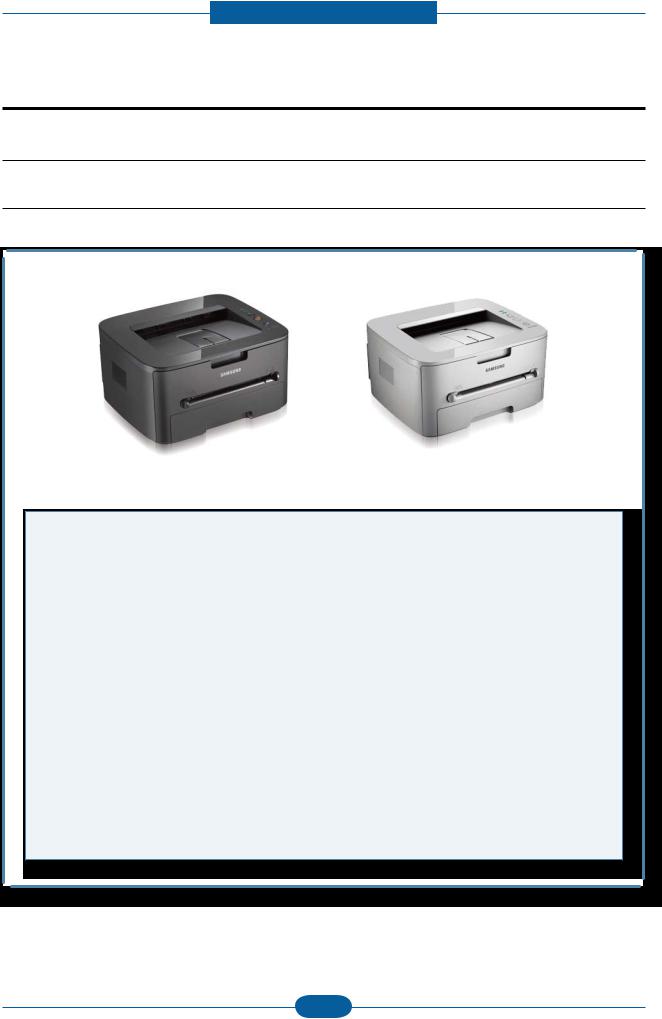
Product spec and feature
2. Product spec and feature
2.1 Product Specifications
2.1.1 Product Overview
ML1915 / 2525 / 2525W |
ML1910 / 2580N |
1.Speed
•ML2525/2525W/2580N : 24 ppm in A4
•ML1910/1915 : 18 ppm in A4
2.Printing Resolution
•Max. 1200x600 dpi effective output (ML-1910/1915/2525)
•Max. 1200x1200 dpi effective output (ML-2525W/2580N)
3.Processor
•Jupiter4e 150 Mhz
•Chorus3 360 Mhz (Only 2525W, 2580N)
4.Printer Language Emulations
•SPL , PCL6 (Only 2580N)
5.Memory
•8 MB
•64 MB (Only 2580N)
6.Interfaces
•One USB port
•One 10/100 BaseT network connector (2580N)
•One IEEE 802.11 b/g wireless LAN (2525W)
7.Control Panel
•No LCD, 3 keys and 2 LEDs
•No LCD, 2 keys and 3 LEDs (only 2525W)
8.Toner cartridge
•Initial : 0.7K (1910/ 1915)
1K (2525/2525W/2580N)
•Sales : 1.5K / 2.5K two types
9.Color
•There are two kinds of colors. (Gray and Black)
Service Manual |
2-1 |
Samsung Electronics |
|

Product spec and feature
2.1.2 Specifications
• Product Specifications are subject to change without notice. See below for product specifications.
2.1.2.1 General Print Engine
|
Items |
ML-1910 / 1915 |
ML-2525 / 2525W / 2580N |
|
Engine Speed |
|
Simplex |
Up to 18 ppm inA4 (19 ppm in Letter) |
Up to 24 ppm inA4 (24 ppm in Letter) |
|
|
|
|
|
|
|
Duplex |
Manual |
Manual |
|
|
|
|
|
Warmup time |
|
From Sleep |
30 sec |
30 sec |
|
|
|
|
|
FPOT |
|
From Ready |
10 sec |
9 sec |
|
|
|
|
|
|
|
From Sleep |
less than 28 sec |
less than 19 sec |
|
|
|
|
|
Resolution |
|
- |
Up to 1,200 x 600 dpi effective output |
- 2525 |
|
|
|
|
Up to 1200 x 600 dpi effective output |
|
|
|
|
- 2525W/2580N |
|
|
|
|
Up to 1200 x 1200 dpi effective outpu |
|
|
|
|
|
Service Manual |
2-2 |
Samsung Electronics |
|

Product spec and feature
2.1.2.2 Controller & S/W
|
Items |
ML-1910 / 1915 |
ML-2525 / 2525W / 2580N |
|
Processor |
|
|
Jupiter4e 150 MHz |
- 2525 : Jupiter4e 150 MHz |
|
|
|
|
- 2525W/2580N : Chorus3 360 MHz |
|
|
|
|
|
Memory |
|
Std. |
8 MB |
- 2525 : 8 MB |
|
|
|
|
- 2525W/2580N : 64 MB |
|
|
|
|
|
|
|
Option |
N/A |
N/A |
|
|
|
|
|
Printer |
|
- |
SPL(Samsung Printer Language) |
- 2525/2525W : SPL(Samsung Printer |
Languages |
|
|
|
Language) |
|
|
|
|
- 2580N : SPL, PCL6, IBM ProPrinter, |
|
|
|
|
EPSON |
|
|
|
|
|
Fonts |
|
- |
Windows Fonts |
- 2525/2525W : Windows Fonts |
|
|
|
|
- 2580N : 45 scalable, 1 bitmap, 136 |
|
|
|
|
PostScript3 fonts |
|
|
|
|
|
Driver |
|
Default Driver |
SPL |
SPL |
|
|
|
|
|
|
|
Install |
SPL |
- 2525/2525W : SPL |
|
|
|
|
- 2580N : SPL, PCL6 |
|
|
|
|
|
|
|
Supporting OS |
Windows 2000/XP(32/64bits)/ |
Windows 2000/XP(32/64bits)/ |
|
|
|
Vista(32/64bits)/2003 |
Vista(32/64bits)/2003 |
|
|
|
Server(32/64bits)/ |
Server(32/64bits)/ |
|
|
|
2008 Server(32/64bits) |
2008 Server(32/64bits) |
|
|
|
|
|
|
|
|
Various Linux OS: |
Various Linux OS: |
|
|
|
- Red Hat 8~9, |
- Red Hat 8~9, |
|
|
|
- Fedora Core 1~4 |
- Fedora Core 1~4 |
|
|
|
- Mandrake 9.2~10.1 |
- Mandrake 9.2~10.1 |
|
|
|
- SuSE 8.2~9.2 |
- SuSE 8.2~9.2 |
|
|
|
Mac OS 10.3~10.6 |
Mac OS 10.3~10.6 |
|
|
|
|
|
|
|
WHQL |
Windows 2000/XP(32/64bits)/ |
Windows 2000/XP(32/64bits)/ |
|
|
|
Vista(32/64bits)/2003 |
Vista(32/64bits)/2003 |
|
|
|
Server(32/64bits)/2008 |
Server(32/64bits)/2008 |
|
|
|
Server(32/64bits) |
Server(32/64bits) |
|
|
|
|
|
|
|
Compatibility |
Win 2000/XP(32/64bits)/2003 Server/ |
Win 2000/XP(32/64bits)/2003 Server/ |
|
|
|
Vista(32/64bits),2008 Server(32/64bits) |
Vista(32/64bits),2008 Server(32/64bits) |
|
|
|
|
|
Service Manual |
2-3 |
Samsung Electronics |
|

Product spec and feature
Items |
ML-1910 / 1915 |
ML-2525 / 2525W / 2580N |
|
Wired Network |
Protocol |
N/A |
TCP/IP, Ethertalk, SNMP, HTTP 1.1 |
|
|
|
(Only 2580N) |
|
|
|
|
|
Supporting OS |
N/A |
Windows NT4.0/2000/XP(32/64bits)/ |
|
|
|
2003 Server(32/64bits)/ |
|
|
|
Vista(32/64bits)/2008 Server(32/64bits) |
|
|
|
Mac OS 8.6~9.2, 10.1~10.4 |
|
|
|
Various Linux OS including Red Hat |
|
|
|
8~9, Fedora Core 1~4, Mandrake |
|
|
|
9.2~10.1, |
|
|
|
and SuSE 8.2~9.2 |
|
|
|
NetWare 5.x, 6.x (TCP/IP Only) |
|
|
|
Unix HP-UX |
|
|
|
|
Wireless Network |
Protocol |
N/A |
|
|
|
|
|
|
Supporting OS |
N/A |
|
|
|
|
|
Application |
Smart Panel |
SmartPanel for Windows/ Macintosh/ |
SmartPanel for Windows/ Macintosh/ |
|
|
LINUX |
LINUX |
|
|
|
|
|
Printer Setting |
N/A |
PSU for Windows/ Macintosh/LINUX |
|
|
|
(Only 2580N) |
|
|
|
|
|
Network |
N/A |
SyncThru WebAdmin Service 4.5 |
|
Management |
|
(Only 2580N) |
|
|
|
|
|
IP Setting |
SetIP |
SetIP |
|
|
|
|
Interface |
|
|
|
Parallel |
- |
N/A |
N/A |
|
|
|
|
USB |
- |
Compatible with USB 2.0 |
Hi-Speed USB 2.0 |
|
|
|
|
Wired Network |
- |
N/A |
Ethernet 10/100 Base TX (Internal) : |
|
|
|
Only 2580N |
|
|
|
|
Wireless Network |
- |
N/A |
N/A |
|
|
|
|
User Interface |
|
|
|
LCD |
- |
N/A |
N/A |
|
|
|
|
LED |
- |
2 LEDs : Icon, No Text |
- 2525/2580N |
|
|
|
2 LEDs : Icon, No Text |
|
|
|
- 2525W |
|
|
|
3 LEDs : Icon, No Text |
|
|
|
|
Key |
- |
3 Keys |
3 Keys (2525/2580N) |
|
|
|
2 Keys (2525W) |
|
|
|
|
Service Manual |
2-4 |
Samsung Electronics |
|

Product spec and feature
2.1.2.3 Paper Handling
Items |
ML-1910 / 1915 |
ML-2525 / 2525W / 2580N |
||
Standard |
|
- |
250-sheet Cassette Tray@80g/ , |
250-sheet Cassette Tray@80g/ , |
Capacity |
|
|
1-sheet Manual Tray |
1-sheet Manual Tray |
|
|
|
|
|
Max. Capacity |
|
- |
251 sheets @ 80g/ |
251 sheets @ 80g/ |
|
|
|
|
|
Printing |
|
Max. Size |
216 x 356 mm (8.5" x 14") |
216 x 356 mm (8.5" x 14") |
|
|
|
|
|
|
|
Min. Size |
76 x 127 mm (3.0" x 5.0") |
76 x 127 mm (3.0" x 5.0") |
Multi-purpose tray |
|
|
|
|
Capacity |
|
Plain Paper |
1 sheet |
1 sheet |
|
|
|
|
|
|
|
Envelop |
1 sheet |
1 sheet |
|
|
|
|
|
Media sizes |
|
- |
A4,A5,A6, ISO B5, JIS B5, B6, |
A4,A5,A6, ISO B5, JIS B5, B6, |
|
|
|
Statement, Letter, Quarto, Oficio, Folio, |
Statement, Letter, Quarto, Oficio, Folio, |
|
|
|
Legal, Envelope(No 10, Monarch, DL, |
Legal, Envelope(No 10, Monarch, DL, |
|
|
|
C5, C6) Postcard |
C5, C6) Postcard |
|
|
|
|
|
Media type |
|
- |
Plain,Thin, Bond, Punched, Pre-printed, |
Plain,Thin, Bond, Punched, Pre-printed, |
|
|
|
Recycled, Envelope, Transparency, |
Recycled, Envelope, Transparency, |
|
|
|
Label, Cardstock, Postcard, Letterhead, |
Label, Cardstock, Postcard, Letterhead, |
|
|
|
Thick, Cotton, Colored,Archive |
Thick, Cotton, Colored,Archive |
|
|
|
|
|
Media weight |
|
- |
16~43lb (60 to 163g/ ) |
16~43lb (60 to 163g/ ) |
|
|
|
|
|
Sensing |
|
- |
Manual Feed Sensor |
Manual Feed Sensor |
|
|
|
|
|
Standard Cassette Tray |
|
|
||
Capacity |
|
- |
250 sheets @ 80g/ |
250 sheets @ 80g/ |
|
|
|
|
|
Media sizes |
|
- |
A4,A5,A6, ISO B5, JIS B5, Executive, |
A4,A5,A6, ISO B5, JIS B5, Executive, |
|
|
|
Letter, Oficio, Folio, Legal,Custom |
Letter, Oficio, Folio, Legal,Custom |
|
|
|
|
|
Media types |
|
- |
Plain, Thin, Recycled, Thick,Archive |
Plain, Thin, Recycled, Thick,Archive |
|
|
|
|
|
Media weight |
|
- |
16~32lb (60 to 120g/ ) |
16~32lb (60 to 120g/ ) |
|
|
|
|
|
Sensing |
|
- |
Paper Empty |
Paper Empty |
|
|
|
|
|
Optional Cassette Tray |
|
|
||
Capacity |
|
- |
N/A |
N/A |
|
|
|
|
|
Media sizes |
|
- |
N/A |
N/A |
|
|
|
|
|
Media types |
|
- |
N/A |
N/A |
|
|
|
|
|
Media weight |
|
- |
N/A |
N/A |
|
|
|
|
|
Sensing |
|
- |
N/A |
N/A |
|
|
|
|
|
Output Stacking |
|
|
|
|
|
|
|
|
|
Capacity |
|
Face-Down |
80 sheets @ 75g/ NN Condition |
80 sheets @ 75g/ NN Condition |
|
|
|
|
|
|
|
Face-Up |
N/A |
N/A |
|
|
|
|
|
Output Full |
|
- |
N/A |
N/A |
sensing |
|
|
|
|
|
|
|
|
|
Service Manual |
2-5 |
Samsung Electronics |
|

Product spec and feature
|
Items |
ML-1910 / 1915 |
ML-2525 / 2525W / 2580N |
|
Duplex |
|
|
|
|
Supporting |
|
- |
N/A |
N/A |
|
|
|
|
|
Media sizes |
|
- |
N |
N |
|
|
|
|
|
Media types |
|
- |
N |
N |
|
|
|
|
|
Media weight |
|
- |
N |
N |
|
|
|
|
|
Printable Area |
|
|
|
|
Non-Printable |
|
Envelop |
10mm(0.4") from edge(Top, Bottom, |
10mm(0.4") from edge(Top, Bottom, |
Area |
|
|
Left, Right) |
Left, Right) |
|
|
|
|
|
|
|
Other Media |
4mm(0.16") from edge(Top, Bottom, |
4mm(0.16") from edge(Top, Bottom, |
|
|
|
Left, Right) |
Left, Right) |
|
|
|
|
|
2.1.2.4 Consumables
|
Items |
ML-1910 / 1915 |
ML-2525 / 2525W / 2580N |
|
Toner |
|
Black |
Standard / High Yield:Average Cartridge |
Standard / High Yield:Average Cartridge |
|
|
|
Yield 1.5K / 2.5K standard pages. |
Yield 1.5K / 2.5K standard pages. |
|
|
|
(Ships with 700 pages Starter Toner |
(Ships with 1,000 pages Starter Toner |
|
|
|
Cartridge) |
Cartridge) |
|
|
|
Declared cartridge yield in accordance |
Declared cartridge yield in accordance |
|
|
|
with ISO/IEC 19752. |
with ISO/IEC 19752. |
|
|
|
|
|
|
|
Key |
Electronic key(CRUM) Only |
Electronic key(CRUM) Only |
|
|
|
|
|
|
|
Life detect |
Toner gauge sensor by dot count |
Toner gauge sensor by dot count |
|
|
|
|
|
Drum |
|
Yield |
N/A |
N/A |
|
|
|
|
|
2.1.2.5 Reliability & Service
Items |
ML-1910 / 1915 |
ML-2525 / 2525W / 2580N |
|
Printing Volume |
- |
121 sheets/month |
- 2525 / 2525W : 166 sheets/month |
(SETAMPV) |
|
|
- 2580N : 197 sheets/month |
|
|
|
|
Max. Monthly Duty |
- |
10,000 SHEET/month |
12,000 SHEET/month |
|
|
|
|
MPBF |
- |
10,000 sheets |
10,000 sheets |
|
|
|
|
MTTR |
- |
30 min. |
30 min. |
|
|
|
|
SET Life Cycle |
- |
50,000 sheets or 5 years (whichever |
50,000 sheets or 5 years (whichever |
|
|
comes first) |
comes first) |
|
|
|
|
RDS |
Comm. Mode |
N/A |
N/A |
|
|
|
|
|
Operation |
N/A |
N/A |
|
|
|
|
Service Manual |
2-6 |
Samsung Electronics |
|

Product spec and feature
2.1.2.6 Environment
Items |
ML-1910 / 1915 |
ML-2525 / 2525W / 2580N |
|
Operating |
Temperature |
10C to 32C |
10C to 32C |
Environment |
|
|
|
Humidity |
20% to 80% |
20% to 80% |
|
|
|
|
|
Acoustic Noise |
Printing |
48dBA |
48dBA |
Level(Sound |
|
|
|
Standby |
Back Ground Level |
Back Ground Level |
|
Power/Pressure) |
|
|
|
Sleep |
Back Ground Level |
Back Ground Level |
|
|
|
|
|
Power |
Ready |
Less than 60W |
Less than 60W |
Consumption |
|
|
|
AVG. |
Less than 350W |
Less than 350W |
|
|
|
|
|
|
Max/Peak |
Less than 400W |
Less than 400W |
|
|
|
|
|
Sleep / Power Off |
Less than 6.5W / Less than 0.8W |
Less than 6.5W / Less than 0.8W |
|
|
(Conformity to EPA) |
(Conformity to EPA) |
|
|
|
|
Dimension |
SET |
389 x 360 x 197 mm |
389 x 360 x 197 mm |
(W x D x H) |
|
|
|
SET Packing |
460 x 422 x 260 mm |
460 x 422 x 260 mm |
|
|
|
|
|
|
Toner |
284 x 231.5 x 47.8mm |
284 x 231.5 x 47.8mm |
|
|
|
|
|
Toner Packing |
400 x 366 x 204 mm |
400 x 366 x 204 mm |
|
|
|
|
Weight |
SET |
6.55Kg |
6.6Kg |
|
|
|
|
|
Toner |
0.7Kg |
0.7Kg |
|
|
|
|
|
Gross |
8.81Kg |
8.92Kg |
|
|
|
|
2.1.2.7 Packing & Accessory
|
Items |
ML-1910 / 1915 |
ML-2525 / 2525W / 2580N |
|
In-Box |
|
- |
Driver & Network Install CD-ROM |
Driver & Network Install CD-ROM |
|
|
|
Power Cable USB Cable (CIS/China/ |
Power Cable USB Cable (CIS/China/ |
|
|
|
Korea/India) Quick Install Guide |
Korea/India) Quick Install Guide |
|
|
|
Warranty Registration Card User's |
Warranty Registration Card User’s |
|
|
|
Manual (PDF File) |
Manual (PDF File) |
|
|
|
|
|
Service Manual |
2-7 |
Samsung Electronics |
|
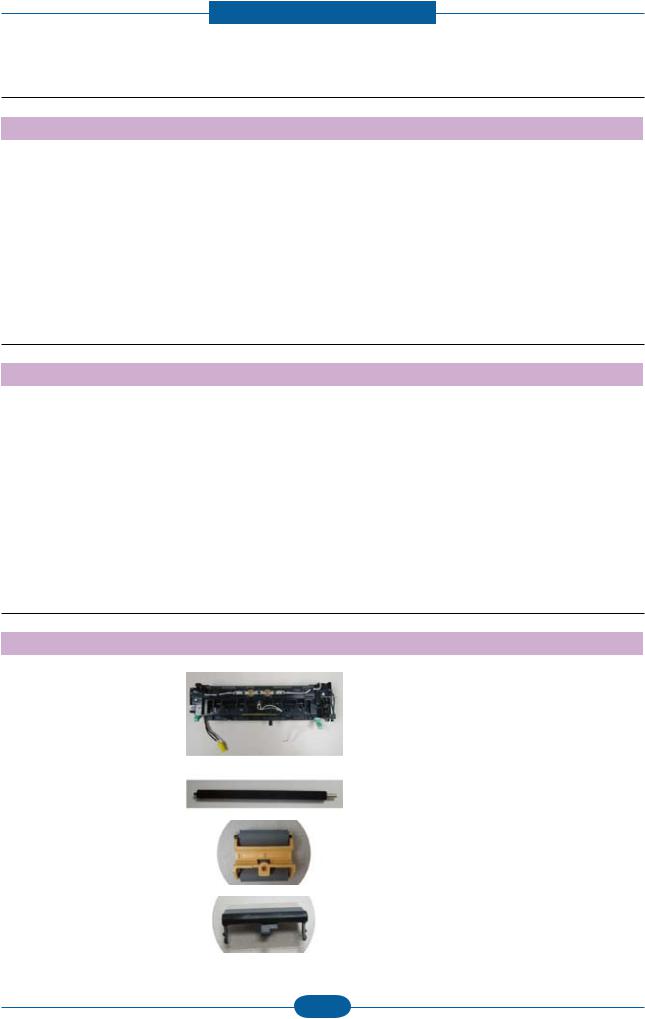
Product spec and feature
2.1.2.8 Options
Items |
ML-1910 / 1915 |
ML-2525 / 2525W / 2580N |
Memory |
N/A |
N/A |
|
|
|
Second Cassette |
N/A |
N/A |
|
|
|
Wired Network |
N/A |
External : Ethernet 10/100 Base TX (Only 2580N) |
|
|
|
Wireless Network |
N/A |
Only 2525W |
|
|
|
Hard Disk |
N/A |
N/A |
|
|
|
Duplex Unit |
N/A |
N/A |
|
|
|
2.1.2.9 Others
|
Items |
ML-1910 / 1915 |
ML-2525 / 2525W / 2580N |
Memory |
Upgradable Mem. Slot |
N/A |
N/A |
|
|
|
|
|
Upgradable Mem. Type |
N/A |
N/A |
|
|
|
|
|
Upgradable Mem. Unit |
N/A |
N/A |
|
|
|
|
Sensor |
Paper Empty |
Yes |
Yes |
|
|
|
|
|
Paper Size |
NO |
NO |
|
|
|
|
|
Media Type |
NO |
NO |
|
|
|
|
|
Paper Full |
Yes |
Yes |
|
|
|
|
2.1.2.10 Maintenance parts (FRU)
Item |
Image |
Part code |
Life |
|
|
- 220V |
|
|
|
: JC91-00945A |
|
Fuser |
|
: JC91-00945B |
50K |
|
- 110V |
||
|
|
|
|
|
|
: JC91-00946A |
|
|
|
: JC91-00946B |
|
|
|
|
|
Transfer Roller |
|
JC66-01218A |
50K |
|
|
|
|
Pick up Roller |
|
JC93-00087A |
50K |
|
|
|
|
Cassette holder pad |
|
JC90-00941A |
50K |
|
|
|
|
Service Manual |
2-8 |
Samsung Electronics |
|

Product spec and feature
2.1.3 Model Comparison Table
|
Samsung |
Samsung |
HP |
|
ML2580N |
ML2240 |
P1505n |
|
|
|
|
Image
Speed |
24 ppm (A4) |
22 ppm (A4) |
23 ppm (A4) |
|
|
|
|
|
|
processor |
360 Mhz |
150 MHz |
266 MHz |
|
|
|
|
|
|
Memory |
64 MB |
8 MB |
32 MB |
|
|
|
|
|
|
Print Language |
SPL, PCL6 |
GDI |
PCL5e |
|
|
|
|
|
|
Input |
250 sheets CST |
150 sheets Bin |
250 sheets Bin, |
|
1 Manual |
10 Manual |
|||
|
|
|||
|
|
|
|
|
Duplex |
Manual |
Manual |
Manual |
|
|
|
|
|
|
Interface |
USB 2.0 |
USB 2.0 |
USB 2.0 |
|
|
|
|
|
|
Size (mm) |
389 x 360 x 197 |
353 x 298 x 213 mm |
379 x 243 x 225 mm |
|
|
|
|
|
|
Toner |
Standard 1.5K / 2.5K |
Standard 1.5K |
Standard 2K |
Service Manual |
2-9 |
Samsung Electronics |
|

Product spec and feature
2.2 System Overview
This chapter describes the functions and operating principal of the main component.
2.2.1 Front View
This illustration may differ from your machine depending on its model.
1 |
Document output tray |
6 |
Manual feeder |
2 |
Control panel |
7 |
Manual feeder guide |
3 |
Front cover handle |
8 |
Output support |
4 |
Front cover |
9 |
Toner cartridge |
5 |
Tray 1 |
|
|
Service Manual |
2-10 |
Samsung Electronics |
|
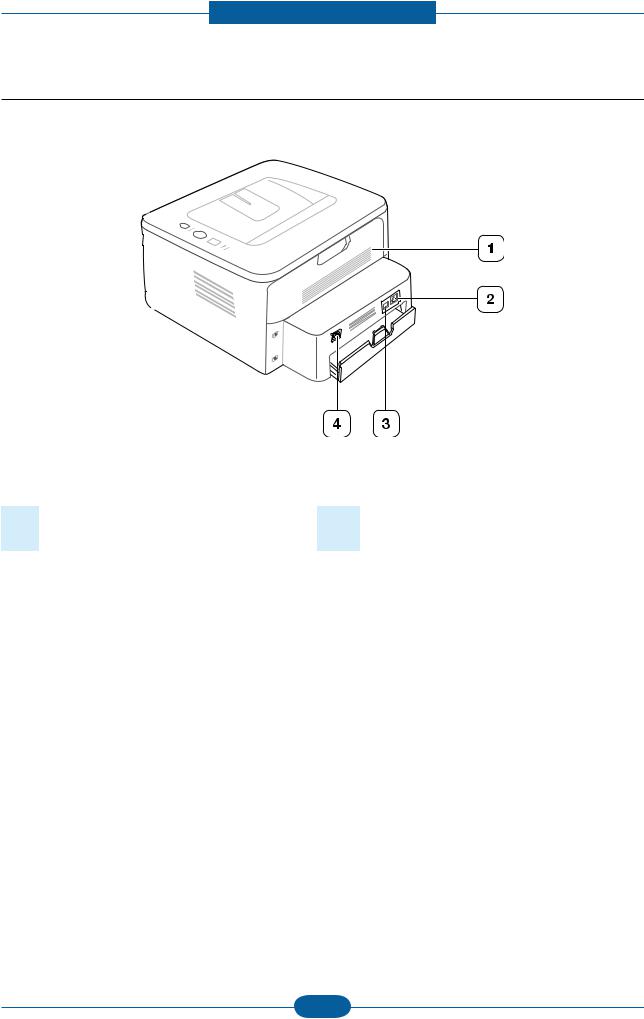
Product spec and feature
2.2.2 Rear View
This illustration may differ from your machine depending on its model.
1 |
Rear cover |
3 |
USB port |
2 |
Network Porta |
4 |
Power receptacle |
a. ML-2580 Series only.
Service Manual |
2-11 |
Samsung Electronics |
|
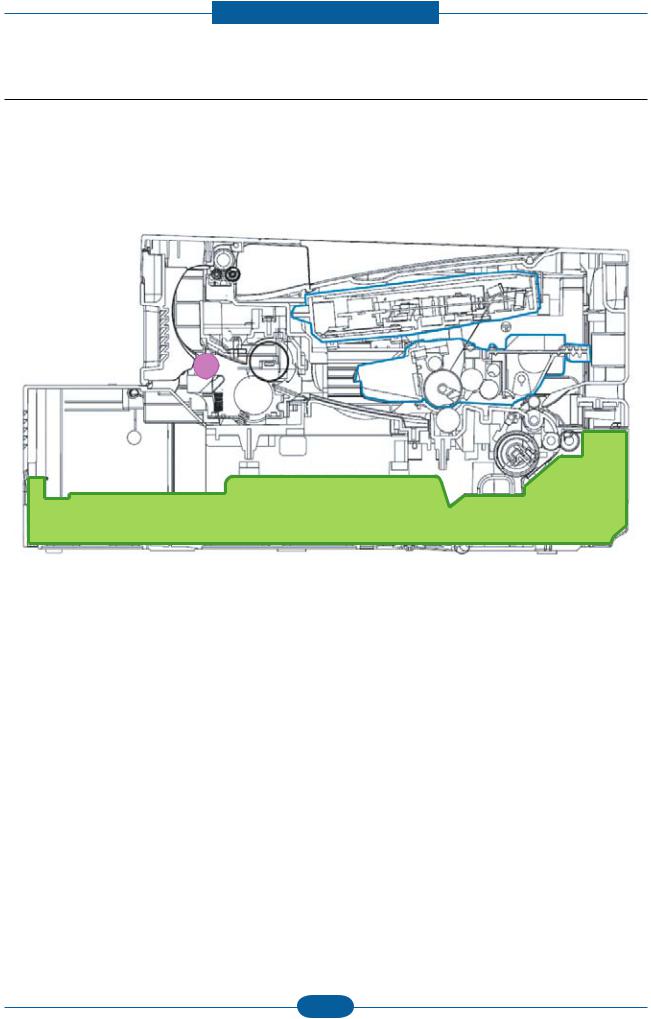
Product spec and feature
2.2.3 System Layout
This model is consisted of the Engine parts and F/W, and said engine parts is consisted of the mechanical parts comprising Frame, Feeding, Developing, Driving, Transferring, Fusing, Cabinet and H/W comprising the main control board, power board, operation panel, PC Interface.
|
1 |
|
|
|
|
3 |
|
15 |
2 |
5 |
4 |
|
14 |
12 |
6 |
|
7 |
||
|
|
||
|
|
|
11 |
10 |
8 |
|
|
13 |
9 |
|
1 |
Top out-bin delivery roller |
|
9 |
Separation Pad |
2 |
Fusing roller |
|
10 |
Pick up roller |
3 |
LSU |
|
11 |
Transfer roller |
4 |
Toner Cartridge |
|
12 |
OPC |
5 |
Primary charging roller |
|
13 |
Cassette |
6 |
Developer roller |
|
14 |
Pressure roller |
7 |
Registration/Multipurpose pick up roller |
|
15 |
Fuser Exit roller |
8 |
Feed roller |
|
|
|
Service Manual |
2-12 |
Samsung Electronics |
|

Product spec and feature
2.2.3.1 Feeding Part
It is consists of a basic cassette, an MP tray for supplying different types of media (envelope, label, special paper) and parts related to paper transferring.
1) Separation method
Paper is separated by the friction pad mounted to the center of the cassette.
2) Basic cassette
It takes a center loading method and applies ‘friction pad separating method.’
Both the side guide and the rear guide can be adjusted for for various types of papers from A6 to legal size paper.
It has a paper existence sensing function
(Capacity: 250 sheets (75g/ paper standard), paper arranging function, various size papers accepting function.
In the front side, there is a paper level indicator.
3) Pickup roller
It has functions such as a paper pickup function, driving control function, paper feeding function, and removing electronic static function. Pick up roller is drive by solenoid.
4) Registration roller
It has a paper arranging function, paper transferring function, paper detecting function, jam removing function, and so on.
5) MP tray
It has a paper arranging function, paper transferring function, jam removing function, and so on.
It uses manual feed method to feed 1 sheets of general papers and 1 envelops.
Service Manual |
2-13 |
Samsung Electronics |
|

Product spec and feature
2.2.3.2 Transfer Roller
-The transfer roller delivers the toner of the OPC drum to the paper.
-There is no PTLAss’y.
-Life Span : Print over 50,000 sheets (in15~30 )
2.2.3.3 Driver Assy
-In ML19102525/2580N, the driving device is consisted of BLDC or Step motor
(BLDC : 2580 / Step : 1910), OPC, Pickup, Feed, GearTrain connected with Mounting member.
•Driving Frequency: BLDCΦ55 Motor : 2400rpm(1800 Clock)
•It is a power delivery unit by gearing: BLDCΦ55 Motor - >Pickup/Feeder/Developer/Fuser/Duplex
Service Manual |
2-14 |
Samsung Electronics |
|
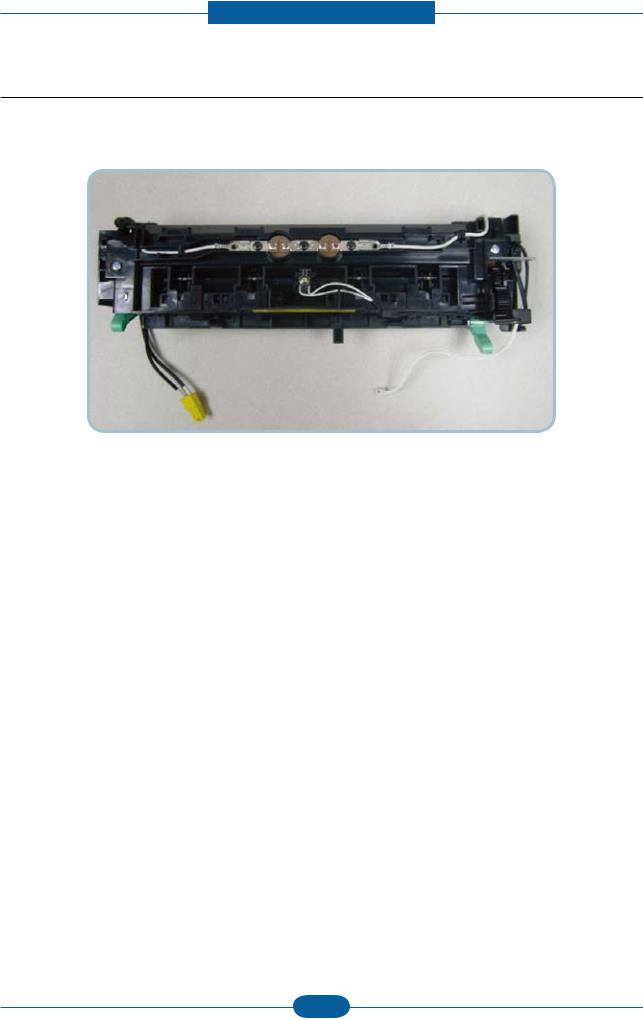
Product spec and feature
2.2.3.4 Fuser
It is consisted of a halogen lamp, heat roller, pressure roller, thermistor and thermostat. It sticks the toner on a paper by heat and pressure to complete the printing job.
1)Thermostat
When a heat lamp is overheated, a Thermostat cuts off the main power to prevent overheating.
-Thermostat Type : NonContact type THERMOSTAT
-Control Temperature : 170 ± 5
2)Thermistor
It is a temperatrue detecting sensor.
-Temperature Resistance : 7 (180 )
3)Heat roller
The heat roller transfers the heat from the lamp to apply a heat on the paper.
The surface of a heat roller is coated with Teflon, so toner does not stick to the surface.
4)Pressure roller
A pressure roller mounted under a heat roller is made of a silicon resin, and the surface also is coated with Teflon. When a paper passes between a heat roller and a pressure roller, toner adheres to the surface of a paper permanently.
5)Halogen Lamp
-Voltage 120 V : 115 ± 5 %
220 V : 230 ± 5 %
- Capacity : 750 Watt ± 25 W
Service Manual |
2-15 |
Samsung Electronics |
|

Product spec and feature
6)Items for safety
Protecting device for overheating
-1st protection device: Hardware cuts off when overheated
-2nd protection device: Software cuts off when overheated
-3rd protection device: Thermostat cuts off main power.
Safety device
-A fuser power is cut off when a front cover is opened
-Maintain a temperature of fuser cover’s surface under 80(C for user, and attach a caution label at where customer can see easily when customer open a rear cover.
Service Manual |
2-16 |
Samsung Electronics |
|
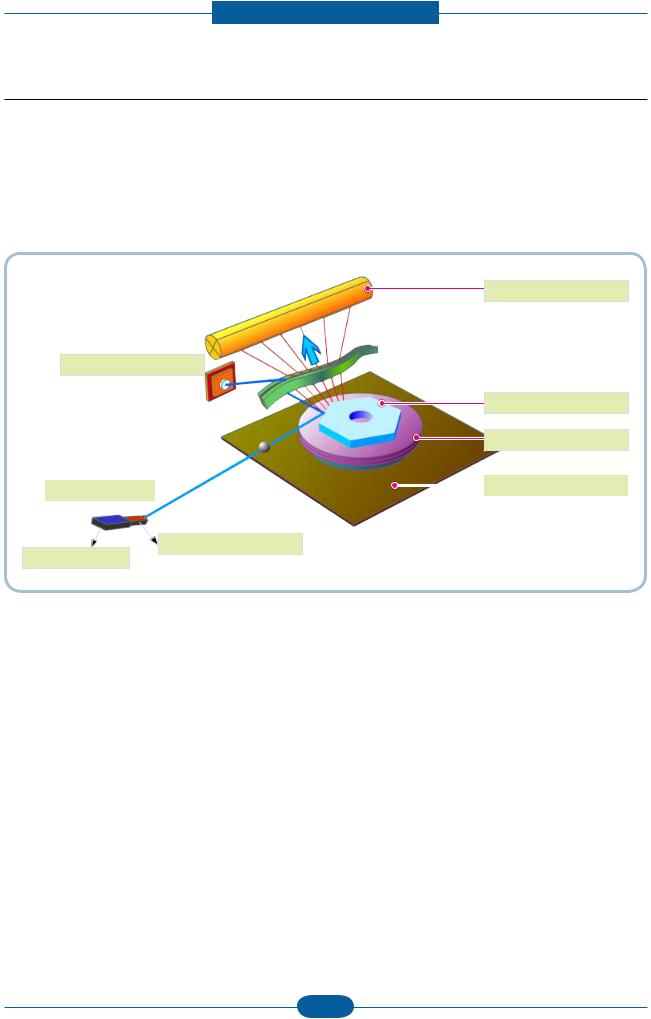
Product spec and feature
2.2.3.5 LSU (Laser Scanner Unit)
It is the core part of the LBP which switches from the video data received to the controller to the electrostatic latent image on the OPC drum by controlling laser beam, exposing OPC drum, and turning principle of polygon mirror. The OPC drum is turned with the paper feeding speed. The /HSYNC signal is created when the laser beam from LSU reaches the end of the polygon mirror, and the signal is sent to the controller. The controller detects the /HSYNC signal to adjust the vertical line of the image on paper. In other words, after the /HSYNC signal is detected, the image data is sent to the LSU to adjust the left margin on paper. The one side of the polygon mirror is one line for scanning.
OPC Drum
Photo Diode
Polygon Mirror
Polygon Motor
|
|
|
|
Motor Driver |
LD Driver circit |
|
|
|
|
|
|
|||
|
|
|
|
|
LD(Laser Diode)
Protector panel
Service Manual |
2-17 |
Samsung Electronics |
|
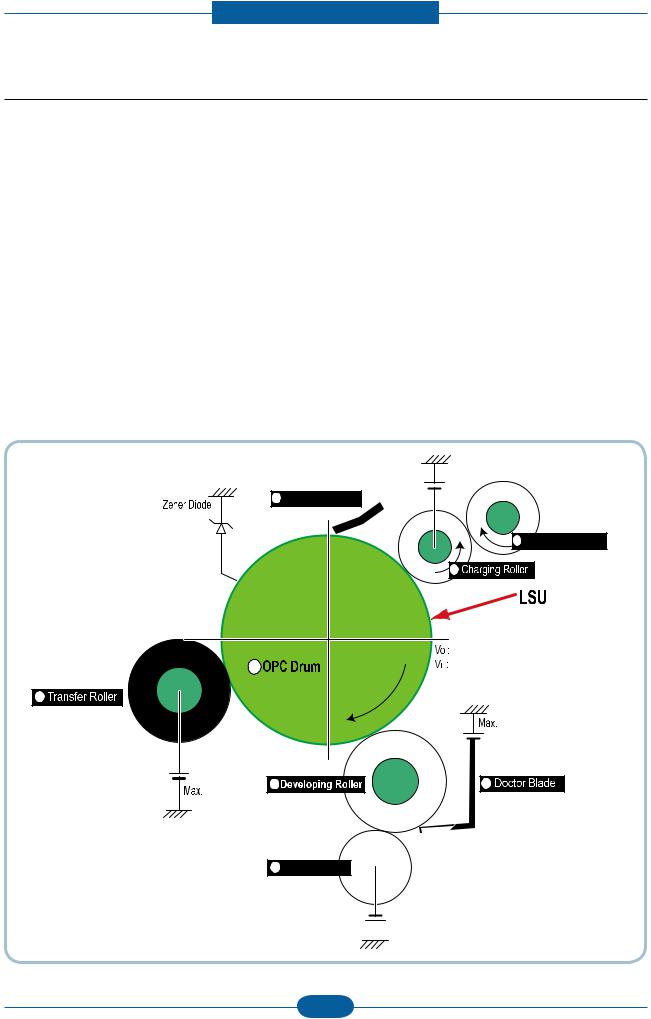
Product spec and feature
2.2.3.6 Toner Cartridge
By using the electronic photo process, it creates a visual image. In the toner cartridge, the OPC unit and the developing unit are in a body. The OPC unit has OPC drum and charging roller, and the toner cartridge unit has toner, supply roller, developing roller, and blade (Doctor blade)
•Developing Method : Non magnetic 1 element contacting method
•Toner : Non magnetic 1 element shatter type toner
•Charging capacity : - 39.1 ± 3 μC/g
•Average OD : 8.0 ± 0.5 (Toner)
•The life span of toner (ISO 19752 pattern / A4 standard)
→Initial toner
-0.7K : ML-1910/1915
-1K : ML-2525/2525W/2580N
→Sales toner
-1.5K / 2.5K
•Toner Residual Sensor : Dot count with CRUM(CRU Monitor)
•OPC Cleaning : Collect the toner by using cleaning blade
•Handling of wasted toner : Collect the wasted toner in the cleaning frame by using cleaning blade
•OPC Drum Protecting Shutter : None
•Classifying device for toner cartridge: ID is classified by CRUM.
8 Cleaning Blade
-100V
Max -1.4KV |
|
2 |
Cleaning Roller |
1 |
|
|
|
0.20mW |
|
|
-720V |
|
6 |
-150V↓ |
7 |
|
|
|
|
-350V |
+5KV |
3 |
4 |
|
|
5 









 -550V
-550V
Service Manual |
2-18 |
Samsung Electronics |
|
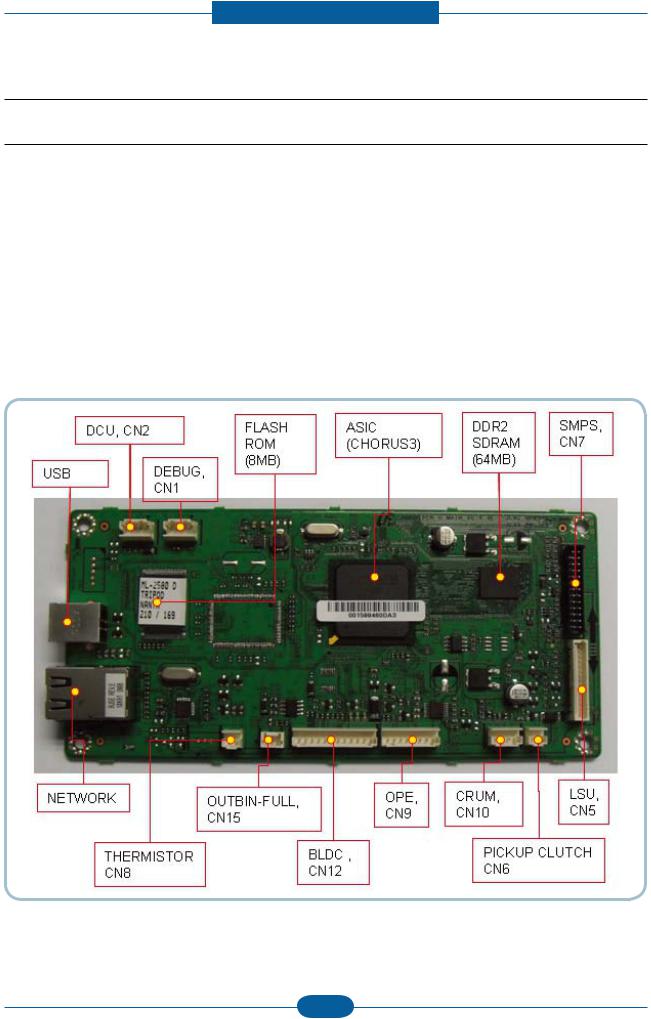
Product spec and feature
2.2.4 Engine H/W Specifications
2.2.4.1 Main PBA
The Engine Board and the Controller Board are in one united board, and it is consisted of CPU part and print part in functional aspect. The CPU is functioned as the bus control, I/O handling, drivers, and PC interface. The main board sends the Current Image of Video data to the LSU and manages the conduct of Electrophotography for printing. It is consisted of the circuits of the motor (paper feed, pass) driving, clutch driving, pretransfer lamp driving, current driving, and fan driving.
The signals from the paper feed jam sensor and paper empty sensor are directly inputted to the main board.
■ ML2580N
The Controller for ML-2580N comprises an ARM-based CPU (Chorus3), DDR2 SDRAM and Flash memories, and other drivers for mechanical elements. The Controller also provides the interface with PC by USB2.0 and Network.
Service Manual |
2-19 |
Samsung Electronics |
|
